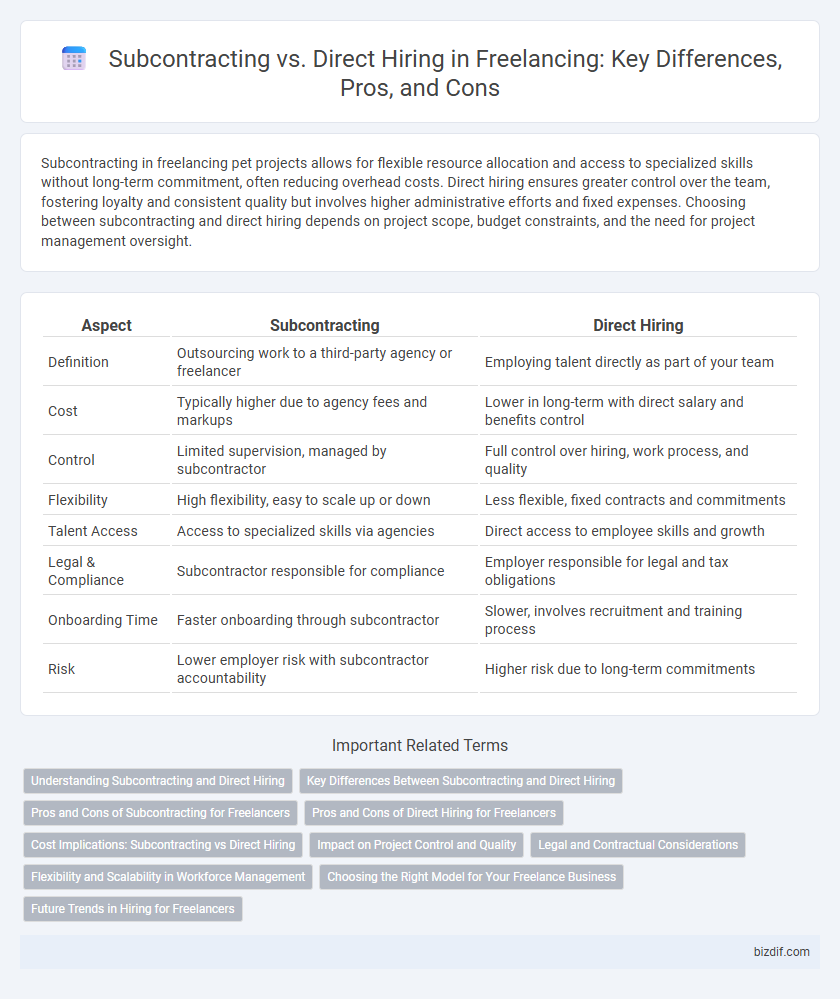Subcontracting in freelancing pet projects allows for flexible resource allocation and access to specialized skills without long-term commitment, often reducing overhead costs. Direct hiring ensures greater control over the team, fostering loyalty and consistent quality but involves higher administrative efforts and fixed expenses. Choosing between subcontracting and direct hiring depends on project scope, budget constraints, and the need for project management oversight.
Table of Comparison
| Aspect | Subcontracting | Direct Hiring |
|---|---|---|
| Definition | Outsourcing work to a third-party agency or freelancer | Employing talent directly as part of your team |
| Cost | Typically higher due to agency fees and markups | Lower in long-term with direct salary and benefits control |
| Control | Limited supervision, managed by subcontractor | Full control over hiring, work process, and quality |
| Flexibility | High flexibility, easy to scale up or down | Less flexible, fixed contracts and commitments |
| Talent Access | Access to specialized skills via agencies | Direct access to employee skills and growth |
| Legal & Compliance | Subcontractor responsible for compliance | Employer responsible for legal and tax obligations |
| Onboarding Time | Faster onboarding through subcontractor | Slower, involves recruitment and training process |
| Risk | Lower employer risk with subcontractor accountability | Higher risk due to long-term commitments |
Understanding Subcontracting and Direct Hiring
Subcontracting involves hiring an external freelancer or agency to complete specific tasks or projects, often managed by a primary contractor, which streamlines workflow and reduces direct administrative burdens. Direct hiring means engaging freelancers personally, fostering closer communication and greater control over project outcomes, but requiring more intensive management and coordination. Understanding the distinctions helps businesses optimize resource allocation, balance flexibility versus control, and ensure contract and payment clarity in freelancing arrangements.
Key Differences Between Subcontracting and Direct Hiring
Subcontracting involves outsourcing specific tasks or projects to external freelancers or agencies, allowing businesses to access specialized skills without expanding their full-time workforce. Direct hiring requires recruiting employees to join the company as full-time or part-time staff, offering more control over work processes but increasing administrative responsibilities. Key differences include contractual obligations, cost structure, long-term commitment, and level of integration within the company.
Pros and Cons of Subcontracting for Freelancers
Subcontracting offers freelancers the advantage of accessing a steady workflow and reducing the burden of client acquisition, allowing them to focus on project execution and skill refinement. However, it often involves lower profit margins due to intermediary fees and less direct client interaction, which can limit relationship-building and long-term networking opportunities. Freelancers must also navigate potential challenges such as unclear communication channels and reliance on the primary contractor for timely payments and project scope definitions.
Pros and Cons of Direct Hiring for Freelancers
Direct hiring offers freelancers increased job security and a stronger working relationship with clients, often leading to better communication and clearer expectations. However, it may involve less flexibility compared to subcontracting, as freelancers typically commit to longer-term projects with fixed schedules. Freelancers also benefit from higher pay rates due to the elimination of intermediary fees but need to manage their own taxes and benefits independently.
Cost Implications: Subcontracting vs Direct Hiring
Subcontracting typically reduces direct labor costs by avoiding expenses such as employee benefits, taxes, and long-term commitments, making it a cost-effective choice for short-term projects. Direct hiring often incurs higher upfront and ongoing costs, including salaries, benefits, training, and infrastructure, but offers more control and potential long-term savings through employee retention. Evaluating the total cost of ownership between subcontracting fees and internal resource investments is crucial for budget optimization in freelancing engagements.
Impact on Project Control and Quality
Subcontracting often reduces direct control over project execution, as tasks are delegated to third-party vendors who may follow different standards. Direct hiring enables closer oversight and seamless communication, which typically results in higher quality outcomes and faster issue resolution. Project managers aiming for stringent quality control and consistent deliverables usually prefer direct hiring over subcontracting.
Legal and Contractual Considerations
Subcontracting in freelancing often involves intricate legal frameworks where the primary contractor remains liable for deliverables, requiring clear contractual stipulations to manage responsibilities and protect intellectual property rights. Direct hiring establishes an employer-employee relationship with defined labor law obligations, including tax withholding, benefits, and termination procedures, demanding compliance with employment regulations. Understanding these distinctions is critical for minimizing legal risks and ensuring enforceable agreements tailored to the nature of the work engagement.
Flexibility and Scalability in Workforce Management
Subcontracting offers superior flexibility by allowing companies to quickly adjust workforce size based on project demands without long-term commitments. Direct hiring provides stability but often limits scalability due to fixed employee contracts and higher retention costs. Leveraging subcontracting enables businesses to efficiently scale operations up or down, optimizing resource allocation and cost management.
Choosing the Right Model for Your Freelance Business
Evaluating subcontracting versus direct hiring requires assessing project scope, budget constraints, and desired control over work quality. Subcontracting offers flexibility and access to specialized skills without long-term commitments, while direct hiring provides greater oversight and consistent collaboration with trusted freelancers. Selecting the right model hinges on balancing these factors to optimize efficiency, cost-effectiveness, and client satisfaction in your freelance business.
Future Trends in Hiring for Freelancers
Subcontracting is expected to evolve with increased reliance on specialized agencies that connect freelancers to projects through streamlined digital platforms, enhancing efficiency and scalability. Direct hiring will grow with advancements in AI-driven talent matching, enabling companies to identify and onboard freelancers whose skills align precisely with project needs. The future hiring landscape for freelancers emphasizes hybrid models combining subcontracting flexibility and direct hiring precision, driven by data analytics and remote work technologies.
Subcontracting vs Direct Hiring Infographic

 bizdif.com
bizdif.com